Howdy, fellow rubber-road enthusiasts! Welcome to your ultimate guide on the wondrous world of tire codes. If you’ve ever been bemused by those cryptic markings on your tires, you’ve come to the right place. Today, we’re taking a deep dive into what 85v, 85h, 85w, 85t, 85s, 85q & 85y mean on a tire. So buckle up, because this is going to be one heck of a fun ride.
What do 85t, 85s, 85q, 85h, 85v, 85w mean on a tire?
These intriguing alphanumeric combinations on your tires aren’t secret codes from a spy movie. They’re actually speed ratings, indicating the maximum speed at which the tire can carry a load corresponding to its Load Index.
| Symbol | Speed Rating Description | Maximum Speed (mph) |
| 85H | High Speed | 130 mph (210 km/h) |
| 85W | Wide Speed | 168 mph (270 km/h) |
| 85V | Very High Speed | 149 mph (240 km/h) |
| 85T | Touring Speed | 118 mph (190 km/h) |
| 85Y | Very High Speed (All Season) | 186 mph (300 km/h) |
| 85S | Standard Speed | 112 mph (180 km/h) |
| 85Q | Winter Tire Speed | 99 mph (160 km/h) |
Now that we’ve demystified these codes, let’s roll deeper into each one of them.
What does 85T mean on a tire?
85T, dear reader, is not just an average, run-of-the-mill tire code. It’s the middle child of tire speed ratings – reliable and unassuming. The ’85’ indicates the tire’s Load Index, which means it can safely support up to 515kg (or 1135 pounds for our imperial-minded friends) of load.
The ‘T’, the pièce de résistance, tells us that this tire is safe to use up to a speed of 118 mph. So, you can’t take this baby on a race track, but it’ll handle your daily drives and road trips like a champ.
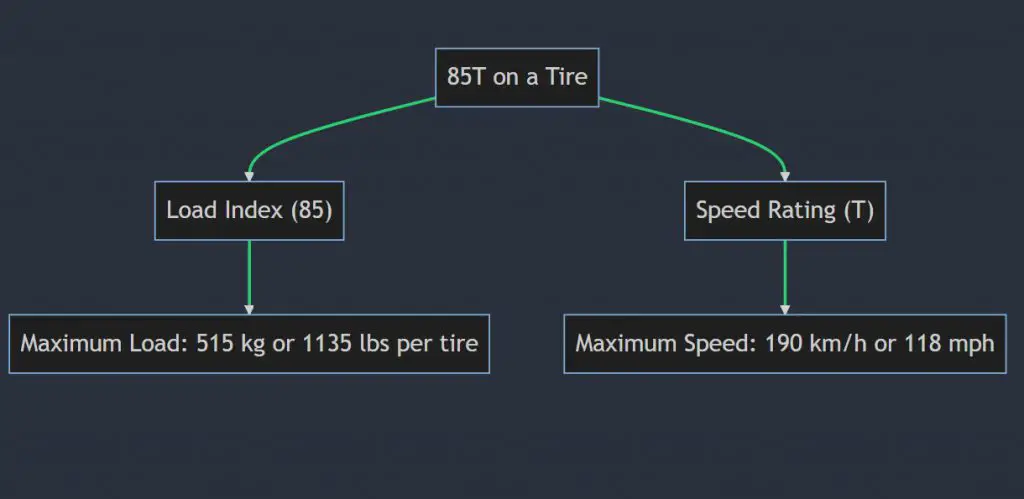
Specifics about 85T Tires
While an 85T tire won’t give you adrenaline-pumping speeds, it promises reliability and practicality.
Typical Use Cases for 85T Tires
85T tires typically feature on standard sedans and minivans. They are the bread and butter for everyday driving in towns, cities, and highways.
Vehicles Suitable for 85T Tires
Here’s a short list of vehicle types that commonly use 85T tires:
- Family Sedans (e.g., Honda Accord)
- Minivans (e.g., Toyota Sienna)
- Compact SUVs (e.g., Subaru Forester)
Precautions when Using 85T Tires
While 85T tires are sturdy and reliable, remember they’re not suited for high-speed driving. Always adhere to the manufacturer’s guidelines to maintain the safety and longevity of your tires.
FAQ’s
- Can I use 85T tires on a sports car?
It’s not advisable. Sports cars usually require a higher speed rating for safe operation.
- Is it safe to use 85T tires for highway driving?
Yes, as long as you maintain a safe speed within the tire’s limits.
What does 85S mean on a tire?
Ah, the 85S! This tire code can be found on many a passenger car. Here, the ’85’ signifies that the tire can carry a load of up to 515kg, while the ‘S’ indicates a maximum speed of 112 mph. Though slower than its 85T sibling, 85S tires are designed to handle most everyday driving situations with aplomb.
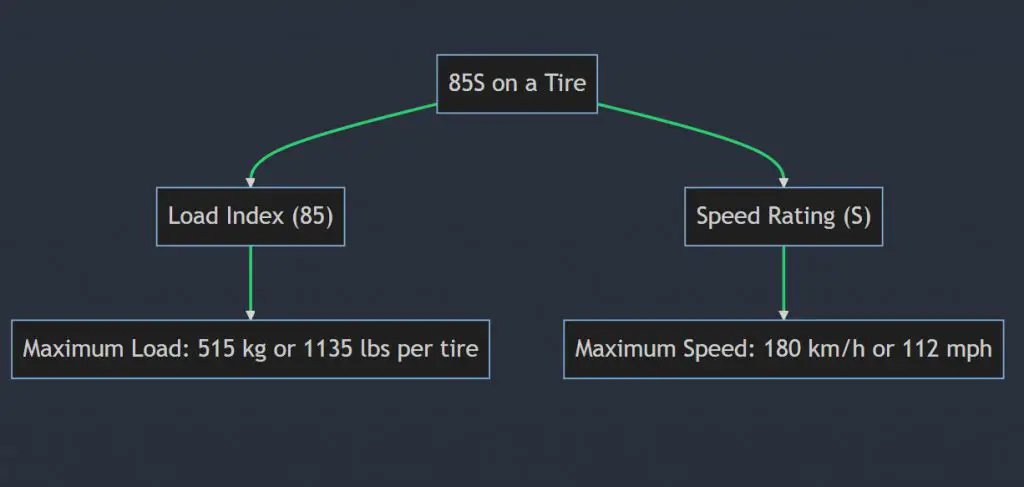
Specifics about 85S Tires
The humble 85S tire is all about balancing performance and comfort for the average driver.
Typical Use Cases for 85S Tires
These tires are commonly used in town and city driving, where high speeds aren’t a necessity.
Vehicles Suitable for 85S Tires
Below are some types of vehicles that can use 85S tires:
- Compact Cars (e.g., Honda Civic)
- Small SUVs (e.g., Ford Escape)
- Midsize Sedans (e.g., Toyota Camry)
Precautions when Using 85S Tires
Just like its 85T counterpart, the 85S is not meant for high-speed thrill rides. Keep within the rated speed limit to ensure safe and comfortable driving.
FAQ’s
- Can I replace my 85T tires with 85S?
It’s generally not recommended, as doing so may affect your vehicle’s performance and safety.
- Are 85S tires suitable for long road trips?
Yes, as long as you maintain a safe speed within the tire’s rated limit.
What does 85Q mean on a tire?
Step right up and behold the unsung hero of winter tires: the 85Q. In this tire speed rating, the number ’85’ tells us that our brave little tire can carry a load of up to 515 kg. Now, that ‘Q’ – that’s where the magic happens. This letter denotes a maximum speed of 99 mph.
You might think, “That’s not very fast,” but let me tell you, when you’re navigating icy roads or powering through a snowstorm, slow and steady wins the race.
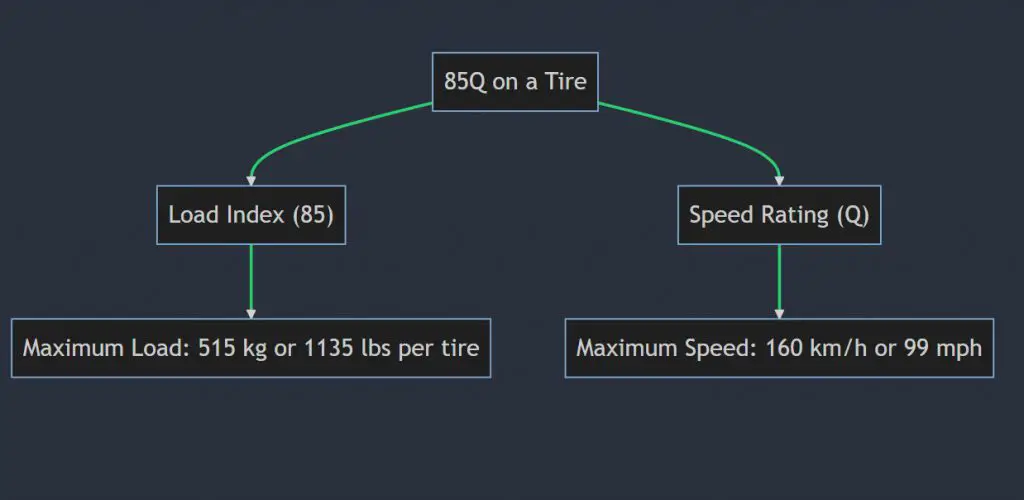
Specifics about 85Q Tires
Don’t be fooled by the relatively low speed rating of the 85Q tires. Their strength lies in their ability to perform exceptionally well in tricky winter conditions.
Typical Use Cases for 85Q Tires
These tires are often used in areas with harsh winters, excelling on icy and snowy roads where maintaining control at lower speeds is essential.
Vehicles Suitable for 85Q Tires
Here are a few types of vehicles that often use 85Q tires:
- Compact SUVs (e.g., Subaru Forester)
- Mid-size Sedans (e.g., Volkswagen Passat)
- Crossovers (e.g., Mazda CX-5)
Precautions when Using 85Q Tires
The 85Q tire is not meant for a summer joyride. These tires perform best in colder climates and may wear quickly if used in warmer conditions.
FAQ’s
- Can I use 85Q tires all year round?
Not advisable. These tires are designed for winter conditions and can wear out quickly in warmer weather.
- Is it safe to exceed the 99 mph speed limit with 85Q tires?
No. Exceeding the rated speed can cause damage to the tire and is a safety risk.
- Can I use 85Q tires on a sports car?
No. Sports cars usually require a higher speed rating for safe operation.
What does 85H mean on a tire?
Allow me to introduce the thrilling 85H tire code! Here, ’85’ represents the load index – a heroic 515 kg. The ‘H’ is where it gets exciting: this tire can safely reach speeds up to 130 mph. So while it may not take you to “ludicrous speed,” it’s no slouch in the fast lane.
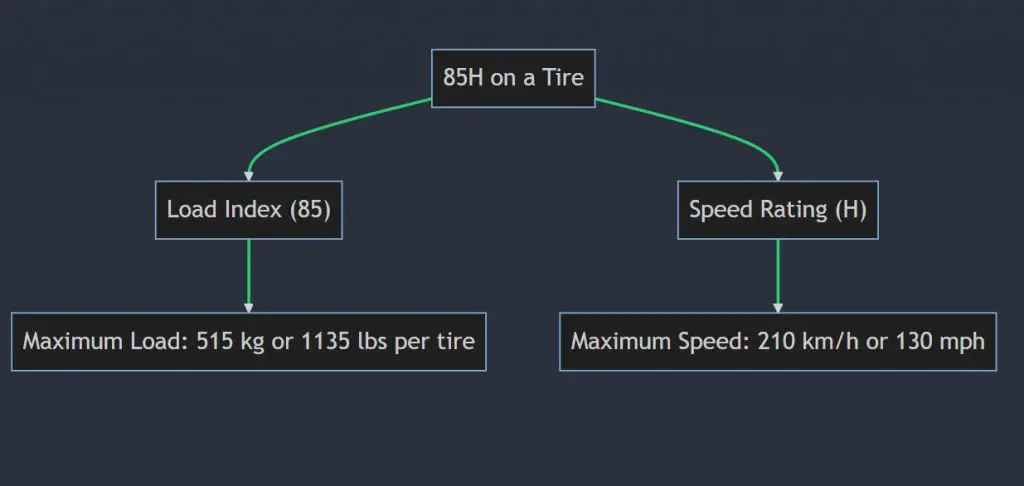
Specifics about 85H Tires
The 85H tire rating offers a blend of speed, safety, and performance, making it suitable for a range of driving conditions.
Typical Use Cases for 85H Tires
85H tires are typically found on vehicles that need to balance everyday drivability with the ability to let loose on open roads.
Vehicles Suitable for 85H Tires
Here are some vehicles typically sporting 85H tires:
- Sports Sedans (e.g., BMW 3 series)
- High-performance Coupes (e.g., Audi A5)
- Sporty Compact Cars (e.g., Volkswagen Golf GTI)
Precautions when Using 85H Tires
Although they are designed for higher speeds, remember that safety always comes first. Always adhere to speed limits and driving conditions.
FAQ’s
- Can I replace my 85T tires with 85H?
If your vehicle’s manual allows it, yes, but be aware that this can affect the ride comfort and fuel economy.
- Is it safe to use 85H tires for highway driving?
Absolutely! Just be sure to respect the speed limits.
- Can I use 85H tires on a heavy SUV?
Not recommended. Larger SUVs often require a tire with a higher load index for safety.
What does 85R mean on a tire?
If we’re talking about the world of tire speed ratings, the 85R is a bit of an enigma. Generally, the ’85’ stands for a load index of 515 kg, but ‘R’ is typically used to designate radial construction rather than a speed rating. However, if you’ve found a tire marked with an ‘R’ speed rating, it’s a very rare and specific tire designed for speeds up to 106 mph. But beware, it’s not meant for your everyday ride around town.
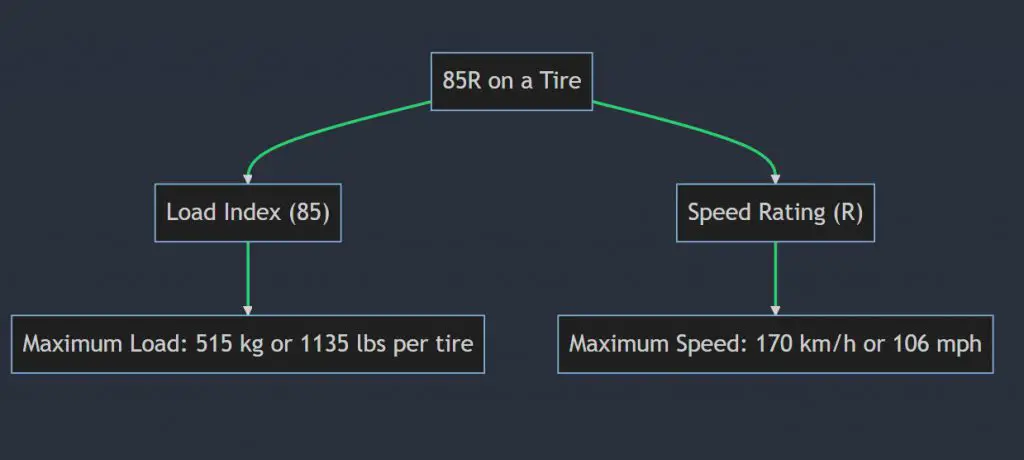
Specifics about 85R Tires
The uncommon 85R tire, although elusive, offers a unique blend of capabilities, performing under pressure and in precise conditions.
Typical Use Cases for 85R Tires
85R tires might be used in unique circumstances or specific vehicles where exact speed and load parameters need to be met.
Vehicles Suitable for 85R Tires
Due to its specificity, it’s challenging to list typical vehicles. However, if your vehicle manual specifies it, you’re in the clear.
Precautions when Using 85R Tires
Don’t get too excited about reaching the 106 mph limit. It’s safer to stay within legal speed limits.
FAQ’s
- Can I replace my 85H tires with 85R?
Only if your vehicle’s manual permits it.
- Can I use 85R tires in any weather condition?
It depends on the specific tire’s design and the conditions for which it’s intended.
- Are 85R tires easy to find?
Not necessarily. They are quite specific and not commonly used in everyday vehicles.
What does 85V mean on a tire?
Ah, the vivacious 85V tire! With the load index ’85’, this tire can safely carry up to 515kg. The ‘V’, on the other hand, stands for Very Fast – okay, not really, but it does signify that the tire can reach speeds of up to 149 mph.
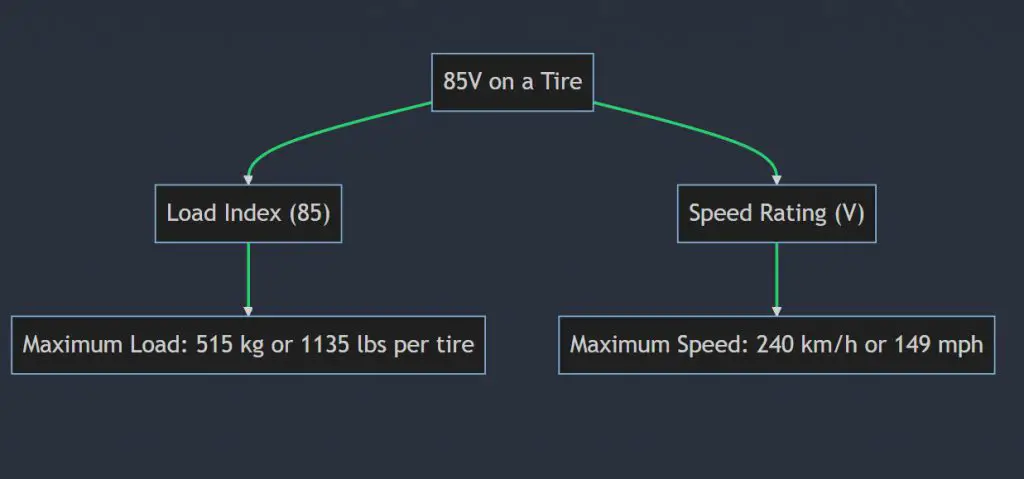
Specifics about 85V Tires
These speed demons are perfect for those who enjoy pushing their vehicle to the limit without compromising safety.
Typical Use Cases for 85V Tires
These tires are often found on sports cars and high-performance vehicles for track days and spirited driving.
Vehicles Suitable for 85V Tires
Here are some vehicles that would enjoy 85V tires:
- Sports Cars (e.g., Porsche 911)
- Performance Sedans (e.g., BMW M3)
- Sport SUVs (e.g., Mercedes-AMG GLC 63)
Precautions when Using 85V Tires
Remember: just because the tire can reach 149 mph doesn’t mean you should try it on public roads.
FAQ’s
- Can I replace my 85H tires with 85V?
It’s possible if your vehicle’s manual allows it.
- Are 85V tires suitable for city driving?
Yes, but they’re best enjoyed on open roads.
- Are 85V tires expensive?
Due to their high-speed rating, they can be pricier than other tires.
What does 85W mean on a tire?
Let’s finish with a bang: the wondrous 85W. With an ’85’ load index, these tires can carry up to 515 kg, and the ‘W’ indicates a maximum speed of a whopping 168 mph. These are not your grandma’s tires, unless your grandma is secretly a Formula 1 driver.
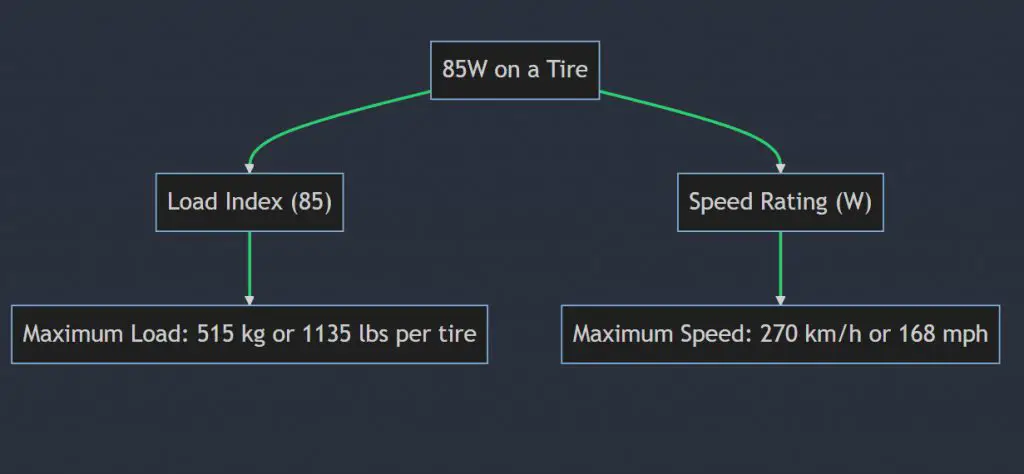
Specifics about 85W Tires
The 85W tire is a real heavyweight champion in the tire world, capable of delivering stellar performance at high speeds.
Typical Use Cases for 85W Tires
These tires are for adrenaline junkies, commonly found on high-performance sports cars and track-day vehicles.
Vehicles Suitable for 85W Tires
Some vehicles that might sport the 85W include:
- Super Sport Cars (e.g., Ferrari 488)
- High-performance luxury cars (e.g., Bentley Continental GT)
- Top-tier sport sedans (e.g., Audi RS7)
Precautions when Using 85W Tires
These tires may offer high-speed capabilities, but always remember to respect local speed limits.
FAQ’s
- Can I replace my 85V tires with 85W?
Yes, if your vehicle’s manual allows for it.
- Is it safe to use 85W tires for everyday driving?
While safe, it may be overkill unless your commute is on the Autobahn.
- Are 85W tires more prone to wear?
They may wear faster due to higher performance levels.
Recap And Summary
Congratulations! You’ve braved the labyrinth of tire speed ratings and load indexes, and emerged victorious. Understanding these figures is no small feat. After all, it’s not every day you get to speak the language of tires. From the sturdy and reliable 85T to the super speedy 85W, we’ve explored a wide range of tire types, their suitable vehicles, use cases, and crucial precautions.
Remember, the ’85’ in these codes signifies the load index. It’s the amount of weight your tire can support when fully inflated, in this case, 515 kg. The letter that follows represents the tire’s speed rating, indicating the maximum speed at which the tire can carry a load corresponding to its load index.
To recap:
- 85T tires are the slow and steady workhorses, suitable for city cars and small sedans.
- 85S tires are a step up, fit for compact and midsize vehicles.
- 85H tires give more speed to family sedans and wagons.
- 85R tires, although a rare breed, can reach speeds of up to 106 mph.
- 85V tires are for the speed enthusiasts, commonly found on sports and high-performance vehicles.
- And lastly, the 85W, the tires that laugh in the face of speed limits, perfect for high-end sports cars.
FAQs
What is the difference between 85T and 85H?
85T and 85H tires share the same load index (85), meaning they can both support up to 515 kg of weight. The difference lies in their speed rating. The 85T tire can reach a maximum speed of 118 mph, while the 85H tire can cruise up to 130 mph.
85H vs 85T: Which is better?
Neither is inherently “better”. It depends on your vehicle’s requirements and your driving habits. If your vehicle manual recommends an 85T, it’s best to stick to it. However, if you seek a bit more speed and your vehicle allows it, an 85H could be a good fit.
85H vs 85V: What’s the difference?
Both 85H and 85V tires can handle the same load (515 kg), but the 85V tire can attain higher speeds (up to 149 mph), while the 85H tire tops at 130 mph.
85V vs 85W: Which is faster?
Although both tires can handle the same load, the 85W holds the speed crown here, with a maximum speed of 168 mph, compared to the 85V’s 149 mph.
Conclusion
Cracking the code of tire markings might seem like a daunting task, one better suited to experienced mechanics or die-hard car enthusiasts. However, with a bit of patience, a dash of humor, and the right guide (ahem, yours truly), it becomes clear that these symbols aren’t as cryptic as they initially appear. They are simply a language developed for our safety and performance on the road.
From the steady and reliable 85T to the high-speed thrill of the 85W, each tire has its unique characteristics, designed to fit the diverse needs of vehicles and drivers alike. We’ve journeyed through the complexities of tire markings together, deciphered their meanings, and hopefully, busted a myth or two along the way.
Whether you’re a cautious commuter, a weekend speedster, or a tire-burning track day enthusiast, there’s a tire out there that speaks your language. It’s a beautiful testament to the wonders of automotive engineering.
Remember, the journey to understanding doesn’t stop here. Always refer back to your vehicle’s manual, consult with professionals, and stay informed. After all, as any car enthusiast worth their salt (or tire rubber) will tell you, the quest for knowledge is a never-ending road. So buckle up, enjoy the ride, and remember – the right tire can make every journey an adventure.
Drive safe, and happy motoring!
Alternative Tire Size Codes of Similar Specifications

AR Jeet has been a tire mechanic for over 2years. He has worked on all types of vehicles, from cars and trucks to RVs and ATVs and motorcycles. He has seen it all when it comes to tires, and he knows how to fix them.
AR Jeet is a tire expert, and he is passionate about his work. He loves to help people keep their vehicles running smoothly, and he is always happy to answer any questions that people have about their tires.
If you need help with your tires, or if you just want to learn more about them, then AR Jeet is the man to talk to. He will be happy to help you out, and he will make sure that you get the best possible solution.
He has a blog [Tirespick.com] where he writes about all things tire-related, and he is always happy to help people with their tire needs. Know more about AR Jeet.
